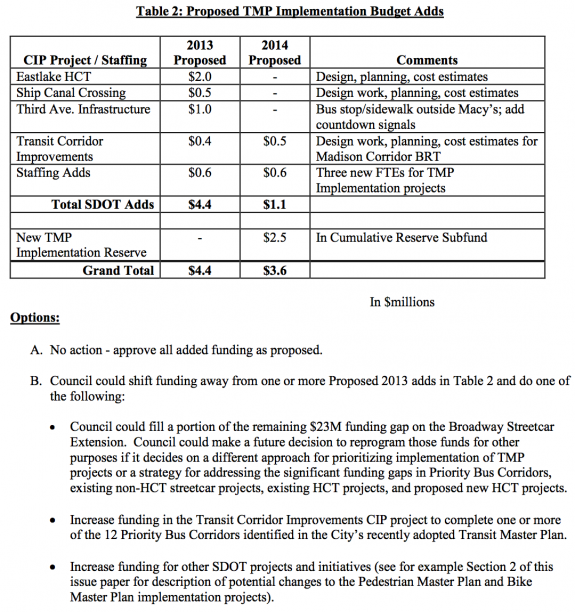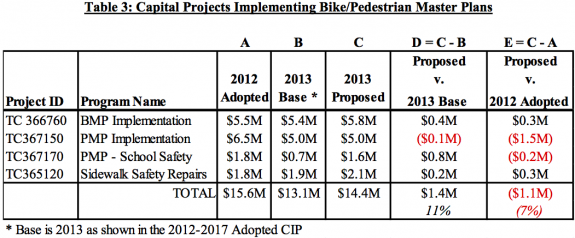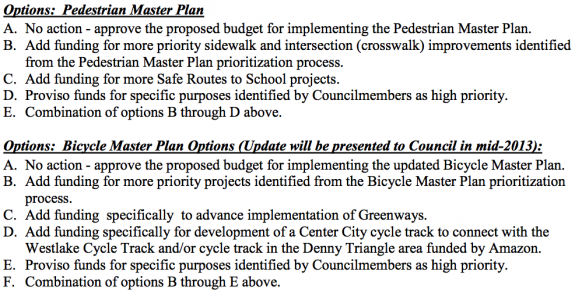The City Council is in the midst of hearings and meetings to discuss which parts of Mayor McGinn’s proposed 2013-14 budget to keep and which parts to scrap. It’s possible that biking and walking projects could get a boost beyond the mayor’s proposed budget, but that could come in part at the expense of high capacity transit planning funds.
Among the council’s potential transportation cuts are about $5 million in high capacity transit projects, including studies for high capacity transit routes to the U-District (likely a streetcar extension) and Ballard as well as a Madison St bus rapid transit project between downtown and 23rd Ave.
According to a presentation to the Council’s Budget Committee Wednesday, here are the options under consideration for the mayor’s HCT planning funds:
The Council brief also noted that the mayor’s proposed funding for biking and walking projects is actually lower than the actual funding for 2012:
Among the options for additional biking and walking funding are boosts to Safe Routes to School, sidewalk improvements, the Bicycle and Pedestrian Master Plans, and neighborhood greenways. Also specifically mentioned: A cycle track to connect the already-funded Westlake cycle track to the mostly-Amazon-funded 7th Ave cycle track. From the briefing:
The high capacity transit funds are not the only potential funding source for these biking and walking increases. The mayor’s budget also did not factor in the city’s real estate excise tax revenue from the recent sale of property in South Lake Union to Amazon. Some of that REET money could go to these boosts.
While increases to biking and walking project funding are always very welcome, many transit boosters are concerned about the loss of the planning funds. With plans completed, the city could be a better position to apply for grant funding for those projects to make rail to the U District and Fremont/Ballard a reality.
It is also worrying that any debate about this funding shift could divide the transit, biking and walking advocacy communities. Using the REET money seems like a great idea. But I’m not excited about using the HCT planning money and strongly urge people not to allow this to become a streetcar vs bike facility debate., which is a dead end argument. Seattle needs both, and is moving far too slowly on making them happen.
All the project plans on the chopping block are priority corridors identified in the city’s recently-completed Transit Master Plan. They are also interconnected with biking and walking safety. For example, the U District project would likely involve a redesign of Eastlake, which is a great chance to advocate for a safer Eastlake for all users. Think: Eastlake Ave cycle track and a safer south end of the University Bridge.
If the Council is going to cut the HCT funding no matter what, then I hope much of it goes to biking and walking projects. But I don’t think it’s a good idea to advocate against transit projects in order to make that biking and walking funding happen.
The Council is scheduled to start voting on budget-related items November 7, and the final budget will be adopted November 19. Thursday was the second of two public budget hearings, but you can still send your thoughts to [email protected].
You can watch the Council’s Wednesday discussion about the funds below (the first section and the section starting around 45:00 discuss Madison):
Below is the presentation document that lays out the options:











Comments
8 responses to “Council considers increases to bike/walk plans, transit funding could face cuts”
Thanks Tom! You’re absolutely right – transit, walking and biking should be “best friends” – not rivals. We need all, and we need them to be developed in a coordinated fashion. Maybe this doesn’t quite belong here – but look what NYC has accomplished by looking at walking, biking, transit and economic development together: http://www.nyc.gov/html/dot/downloads/pdf/2012-10-measuring-the-street.pdf
So the idea is to advance walk/bike lanes and cut transit? Are you kidding me? This isn’t San Diego CA. This is Seattle WA, just short of the Canadian border, if the council needs any geographic reminder. And there are many people for whom the transit is needed given it is a number of miles away from residential areas to workforce locations. You’re telling me this plan takes into account people, on days when it is 34 degrees and sideways raining, that they should get on their bike and get to work 10-20 miles away because the council thinks walk/bike plans are more important that transit? No wonder Seattle is a laughingstock of this country for it’s lack of any cohesive transportation plan that should include transit first and walk/bike second. Our roads are for crap wherever you drive, buses don’t even run in places on Sundays anymore, stranding many working people to finding rides in cars or taking taxis. We have communities like Bellevue, whose council doesn’t give any thought to the many working people in the area who would benefit greatly from light rail. And forget the communities north of Seattle lining up to fight light rail coming thru to Lynnwood, once again deciding that if they have cars then forget the people who consider transit to be their only form of transportation.
The city of seattle is a joke when it comes to approaching anything cohesive in planning transportation needs or transit first, instead of considering the future we’re headed for as more growth occurs, thus more people needing transit. And the cars needing better roads.
I can agree that walk/bike lanes are needed, definitely. But not to the exclusion of a much wider population that can’t take advantage any walk/bike plans, no matter how considered and cheaper they are.
Start looking at the wider areas for transportation needs, come up with a plan for how to move an increasing public on transit first and you’ll start realizing the plans for walk/bike will make more sense when you remove the congestion of cars in a city that has come up with a solution before looking at the problem.
I completely agree that transit and biking/walking work need to go together. I think the argument against these plans is that we already have too many unfunded transit plans (like the downtown streetcar to connect the first hill and south lake union lines). Is this a good argument? I honestly don’t know. But it seems like whatever we can do to get better Seattle transit moving is a good idea.
The points you make about Bellevue and north king county are not really relevant here because this is Seattle-only. A big reason why McGinn wants these plans is because sound transit is moving too slowly on regional rail. That’s a whole other level of politics that I am not totally familiar with (but seems like a frustrating world).
Another reason McGinn and others are pushing for Seattle transit studies is because ST’s regional plans completely ignore parts of Seattle with serious transit demand in favor of building new train tracks along freeways to parking lots — sending a train to do what the buses can do easily. SLU and First Hill weren’t getting any help from ST, and neither will Ballard, the Madison corridor, etc.
Seems like a push to get the bike projects fast-laned because the next mayor may not be as focused on them as the current one has been.
So presumably this means we can now forgo the $20 car tab tax that has been added to our car tabs.
[…] As we reported last week, $5 million of high capacity transit planning money in the mayor’s proposed budget is facing potential cuts as the City Council deliberates the 2013-14 budget. That money—which would be used to study and design high capacity transit routes to the U District, Fremont/Ballard and along Madison St among other projects—could shift to other transportation issues like the biking and walking master plans and filling the funding gap for the Broadway streetcar extension on Capitol Hill. […]
[…] The Seattle Transit Blog writers are not in agreement about an Eastlake streetcar (and the Council’s plan to cut funding to plan it). […]